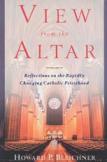Toward Higher Ground
View From the Altar is a must-read for all who are interested in understanding the causes of the scandal of sexual abuse by members of the Catholic clergy. Howard Bleichner, a Sulpician priest who has served for 40 years in seminary formation, 20 of them as rector of two major seminaries, deserves to be heard. His conclusion: the scandals coming to light in the 1970’s and 1980’s were a consequence of the inadequate seminary formation during the years 1967 to 1980.
Part One presents Bleichner’s thesis. Seminary formation from Trent to 1967 was stable and unchanging, much like the church itself. “The seminary deliberately cultivated the quality of an igloo, a place frozen in time. If the church was a timeless, unchanging institution in a changing world, its best and most vivid exemplar was the seminary and its devotion to a rule of life that remained unchanged from one generation to the next. The outside world had little impact on and no point of entry to this self-enclosed world.”
This system remained intact and was successful in providing structure for priests until the Second Vatican Council (1962-65), and then it collapsed: “The Tridentine seminary’s only response to the tremors of the Council was to totter briefly on its foundation and collapse. And the collapse was total.”
Emerging in its wake was a very different system. The primary operative assumptions of seminaries and seminarians were not the traditional Catholic doctrinal and moral certainties of the Tridentine seminary but the insights of self-actualization psychology found in authors like Carl Rogers and Abraham Maslow. This approach, though offering valuable guidelines for human growth, has latent within it two fateful side effects. Bleichner notes that these side effects are the key to understanding the mentality of seminarians and hence the subsequent sexual experimentation by priests emerging in the 1970’s and 1980’s, including same-sex scandals with minors. “First, when the self-actualization model is used, it often empties sinful actions of their objective content. Self-actualizers are set on an expanding continuum of personal growth, and ‘sins’ are regarded as setbacks on the road to ever greater progress. Second, by definition, self-actualization places a low estimate on the value of rules. Rule-bound behavior is other-directed, external compliance to an outside agent. By contrast, the fully actualized person acts from internal motivation. Such persons are a rule unto themselves.”
To illustrate his thesis Bleichner traces by decades the results of a New York Times survey of reported sexual abuse by priests from 1950 to 2002. The numbers highlight the problem: the reported cases grew from 256 in the 1960’s to 537 in the 1970’s and 510 in the 1980’s and then decreased significantly in the 1990’s to 210. Bleichner sees a direct connection between the graduates of the self-actualization seminaries (1967 to 1980) and subsequent clerical sexual scandals.
The remainder of the book spells out how in the 1980’s the seminary system renewed itself, responding to the Second Vatican Council and to the rapidly changing American culture. Since the external supports of the pre-Vatican II Catholic subculture no longer existed, the seminaries focused explicitly on providing an interior spiritual formation, an “interior compass,” for the seminarian, who now needed a more internalized vision of the priesthood of Jesus Christ. “The compass should help him discern where real and ideal meet. It should tell him when he is on track. It should also let him know when he fails and how badly he fails.”
Parts Two and Three describe this interior compass. Part Two focuses on the personal spiritual life of the seminarian and includes chapters on personal and liturgical prayer as well as on the evangelical counsels; Part Three surveys the renewed theology of church and holy orders and includes chapters on the priest as minister of word, as minister of sacraments and as shepherd.
And there is good news. The system is working—witness the dwindling number of sexual clerical abuse cases in the 1990’s. Bleichner’s comment about his final year as a seminary rector is heartening: “The students at Theological College in my final year, 2002, were by far the best and healthiest group of seminarians I had encountered in a long career.”
One personal note. As one of those “self-actualization seminarians,” who even did a dissertation on Abraham Maslow, I am grateful to Bleichner for this book. I had never understood fully the transitions that my fellow seminarians and I suffered through in the 60’s. I find his thesis insightful in explaining our attitudes and behavior.
I am also grateful to the author for handling this sensitive topic with both raw honesty and brotherly compassion. “I wrote this book because I care deeply about the Roman Catholic priesthood. Like other Catholics, I was horrified at and scandalized by the steady stream of stories of the sexual abuse of children and young people by priests that began rolling out in January, 2002. I was revolted by attempts to hide these incidents, ignore victims and evade responsibility. For me as a priest, horror mixed with shame because I could not separate myself from the perpetrators of such unspeakable deeds. I was joined to them in the priesthood of Jesus Christ.”
View From the Altar reminds us that spirituality must be at the core of seminary formation. The church can ignore this message only at great peril to its existence.
This article also appeared in print, under the headline “Toward Higher Ground,” in the November 29, 2004, issue.








